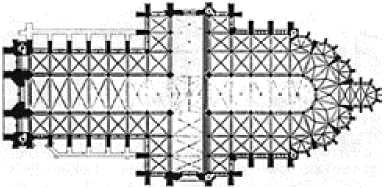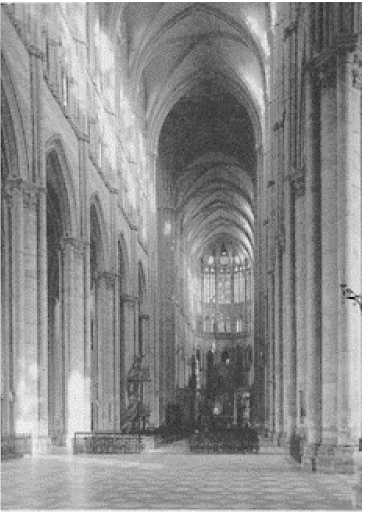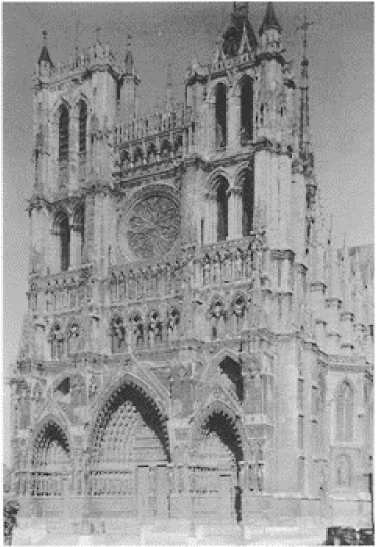. Throughout the Middle Ages, Amiens (Somme) was an important artistic center known for its architecture, sculpture, manuscript illumination, and painting. The cathedral is the city’s outstanding monument. After a fire in 1218, rebuilding commenced ca. 1220 and was substantially completed by 1269. The architect, Robert de Luzarches, was succeeded by Thomas de Cormont and his son Renaud, who finished the upper levels and chevet. Additions included 14th-century chapels in the nave, two western towers, and reconstruction of the spire over the crossing after a 1528 fire.
Amiens represents the epitome of French Gothic architecture. The double-aisled, rib-vaulted cathedral has seven bays in the nave, four in the choir, a slightly projecting transept, and a chevet with seven radiating chapels. The 3:1 proportion of vault height to nave width, and the elevation, whose arcade equals the combined height of the triforium and clerestory, accent the verticality. Piers, ribs, and tracery of clerestory windows convey an impression of lightness and skeletal linearity. Most of the medieval stained glass has been destroyed.
On the exterior, the flying buttresses and sculptured portals typify the Gothic style. The west fagade, dated ca. the 1230s, with three recessed porches, is the most unified iconographic and stylistic ensemble of French Gothic sculpture. The central portal depicts the Last Judgment in the tympanum with the famous trumeau of Christ, Beau Dieu,

Amiens (Somme), Notre-Dame, plan. After Addis and Murray.

Amiens, Notre-Dame, nave. Photograph courtesy of Whitney S. Stoddard.
And jamb figures of the Apostles. The left portal is dedicated to St. Firmin, the first bishop-martyr of Amiens, with other local saints on the jambs. The Virgin is honored on the right door with a tympanum depicting her death and coronation and jamb figures representing an infancy cycle. The piers and basements contain statues and reliefs of prophets, Virtues and Vices, and signs of the zodiac and months. The heavy drapery with broad angular folds enhances the direct presentation of iconographic themes.
The south portal of ca. 1270 features a trumeau statue of the Virgin and Child, Vierge Doree, and scenes from the life of St. Honore, a 6th-century bishop of Amiens, in the tympanum. Swaying poses, delicate faces, and complex drapery characterize this elegant Gothic style. Two 13th-century bishops have bronze slab tombs in the nave. Two chapels of ca. 1375 contain statues of Charles V and his sons. John Ruskin called the late 15th-and early 16th-century carved choir screen and stalls the “Bible of Amiens” because of their wealth of scriptural subjects. The 13th-century edifice, its sculptured portals, and Gothic furnishings make Amiens one of the great medieval churches.
Karen Gould
[See also: CORMONT; GOTHIC ARCHITECTURE; GOTHIC ART: ROBERT DE LUZARCHES]

Amiens (Somme), Notre-Dame, fagade. Photograph: Clarence Ward Collection. Courtesy of Oberlin College.
Hubscher, Ronald, et al. Histoire d’Amiens. Toulouse: Privat, 1986.
Jantzen, Hans. High Gothic: The Classic Cathedrals of Chartres, Reims and Amiens. New York: Pantheon, 1962.
Thiebaut, Jacques. Les cathedrales gothiques en Picardie. Amiens: Centre Regional de Documentation Pedagogique d’Amiens, 1987.




 World History
World History









